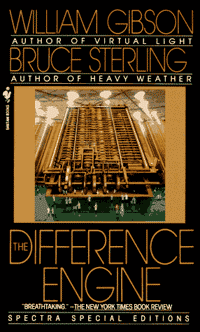
This picture of part of the difference engine's printer linked to from brianjmatis' Flickr photostream, he owns the picture; made available under a creative commons license, some rights reserved.
I've had an on/off love of Bruce Sterling's fiction. I love all his non-fiction and I love hearing his talks. I find him to be a huge intellectual inspiration, and I also find his emotional engagement with design to be moving and genuine. I'm predisposed to appreciate the unique quirks of his style, which I think probably makes up for a lot.
That said, I got completely lost in a bad way inside The Difference Engine. I still have no idea what actually happened in that book.
This novel is the ancestor of the Steampunk aesthetic, but as far as I can tell sits back there at the bottom of it all, forgotten and unloved. Victorian flavored technopunk art has spread out omnivorously through a garden of influences, these days taking a much more absurdist, fantastical stance than Sterling and Gibson's solidly engineered extrapolation. Steampunk aestheticians are more likely to point to Jules Verne or HG Wells as influences, and engage in vampire hunting and ectoplasmic misadventures.
But the subgenre was founded on cryptography and pressure driven gears.
So a couple of months ago in a discussion I was talking up the virtues of Sterling's book The Caryatids and managed through sheer force of my mighty rhetoric to drive Allana to the library, an expedition from which she returned disappointed. In the conversation that followed about aspects of Bruce Sterling's fiction that do or don't work for us, we ended up sort of challenging each other to a public re-read of what I think of as his most unreadable novel. This is the result.
We'll get going on the reading in a couple of days, and conduct an ongoing dialog/argument here as we go. We'll try throwing in some background, history, perspective based on the time it was written (1990), and how it reads in a contemporary context.
I hope to finally figure out what actually occurs in it, and maybe even remember a character or two this time!
(Spoken with affection - as I love most of the work of both Sterling and Gibson. This book remains their problem child. I'm willing to give it the chance of proving itself a misunderstood prodigy after a second, careful read.)
So - over to you, Allana; say hello to the people, and tell us what you're up to here!
- Bill
Completely lost in a bad way...
Written by Bill on Sunday, March 28, 2010
Subscribe to:
Post Comments (Atom)




I do want to mention a few things I liked about Sterling and The Caryatids - his ideas, mainly. He is the Idea Man to me; his brain seems like it's spinning never-endingly, always sucking in diverse information and spitting out clever concepts. I watched a bit of his keynote address to the Augmented Reality folk (the one linked on Bill's site, for those of you following along at home), and I love his energy and his passion, this great vision he has of a future where these technologies are already sealed in gold. And, like you said, his personal quirks are enjoyable to watch and hear. But they never translate well into fiction for me. His execution, his ability to make this stuff believable and nonchalant, just isn't there. The delivery of his ideas is always stilted in fiction, and I feel bad knowing that the great content is off-limits to me because I can't turn a blind eye to the form.
ReplyDeleteThe funny thing is I can absolutely see all the weaknesses in execution that you are pointing out, but they mostly don't get in the way for me. I just get swept along in the thrill ride of his ideation.
ReplyDeleteOne of the things I think he's best at, that I don't see done as well by other science fiction authors, is his ability to both produce amazing ideas and then right away look at them with the skepticism of someone for whom that amazing thing is a fact of the past. He writes about the future from the point of view of the further future, if that makes sense. He tosses off mind bombs and then exposes them as duds all at once.
And somehow, in doing this, he still makes the things seem marvelous. It's like, say, before airplanes, if Jules Verne wrote about people travelling the globe in a day by air, and was able to both intuit the ugly tedium of airport bureaucracy and the wonder that such a feat could be made so commonplace as to be annoying. That people would be able to fly through the air to the opposite side of the world in one day, and the main thing they'd take away from the experience would be fatigue and irritation.
Bruce Sterling does that all the time.
Maybe that makes him an obvious choice to be one of the founders of the steampunk concept. Maybe he'll be able to extrapolate a wonderfully banal present out of miraculous Victorian machinery.
A Sterling quote you might enjoy (from the essay I linked in another comment):
ReplyDelete"The ‘pre-distressed antique futurity’. William Gibson wrote about this when he was writing about atemporality, associating it with his ‘Zero History’ novel that he is working on. Gibson was saying that if you have a genuinely avant garde idea, something that’s really new, you should write about it or create about it as if it were being read twenty years from now. In other words, if you want to do this, you want to strip away the sci-fi chrome, the sense of wonder. You want it to be antique before it hits the page or the screen. Imagine that it was twenty years gone into the future. Just approach it from that perspective."
The best of Sterling's fiction is sublime. "The Shores of Bohemia," "Our Neural Chernobyl," and Holy Fire are just wonderful.
ReplyDeleteThe Difference Engine is nearly up with those in terms of visionary imagination, but adds a historical dimension, and brilliantly spotlights the clash of culture with science and technology. ("It is the business of the future to be dangerous, and it is among the merits of science that it equips the future for its duties."-- A.N. Whitehead.)
I was personally very disappointed by The Caryatids. I can't fault its imagineering; I just couldn't believe or care about the characters.
Stefan, I think in the original disagreement with Bill about The Caryatids, I called the women "paper dolls of virtue and vice." Hard to care about, indeed.
ReplyDeleteArrg! I actually liked the women in The Caryatids... well, all of them except Biserka, who was a caricature - but I really felt the other sisters were operatic, but not one dimensional.
ReplyDeleteI found the imagined government by celebrity cataclysm in Los Angeles thrilling. It was a really unique set of ideas! And the super science city in the Gobi Desert was just cool. Sonja's romance with the desert warlord was ridiculous in scope but plausible in detail, which is a combination that almost always succeeds with me.
I just loved the bent but still moving future of that book. If I had to come up with a stock descriptor for it, I'd call it Post-Post-Apocalypse fiction. The post-apocalypse is so 20th century. Bruce is past all that now!
Anyway, I'll go down fighting for that book. I loved it.
I haven't read his earlier short stories or most of his actual cyberpunk fiction, so maybe it pales in comparison. I actually didn't like Holy Fire that much, I just couldn't find an entry into that story, though I really, really wanted to.
I loved Distraction and Zenith Effect, and the stories in Visionary in Residence are unbelievably great. The one about the alien in Crusader Jerusalem was like nothing I've ever read from him. The cell-phone translation program mediated cross cultural romance story that starts the collection is a perfect sprig of fiction.
Ah well - I guess I'm glad everyone hates the Caryatids but me. If not for that argument, we wouldn't be doing this now, and this is shaping up to be some fun!